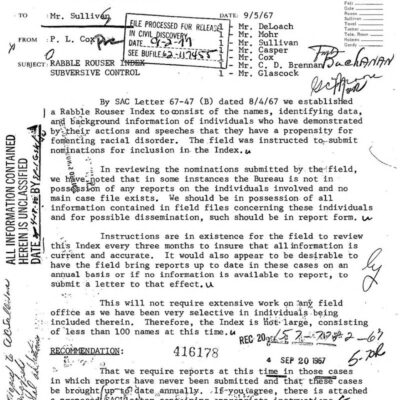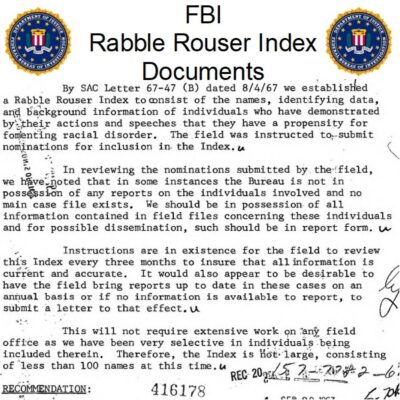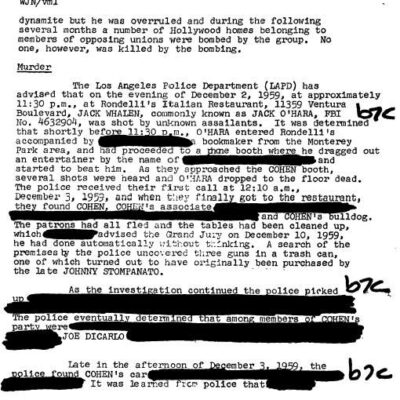
Description
Dahmer: Discovery and Initial Investigation
Detailed Timeline of Events:
- May 21, 1960: Jeffrey Lionel Dahmer is born.
- 1978 – July 22, 1991: Jeffrey Dahmer commits the rape, murder, and dismemberment of 17 men and boys.
- January 1979: Dahmer enlists in the U.S. Army with the initial aspiration of becoming a military police officer. He is trained as a medical specialist instead.
- January 1979 – March 1981: Dahmer’s Official Military Personnel File documents his service, including incidents related to alcoholism.
- June 1980 – March 1981: Disciplinary actions against Dahmer are recorded in his military file. These are linked to his issues with alcohol.
- December 1978 – March 1981: Dahmer’s medical records within his military file detail his issues, likely related to alcohol abuse.
- March 1981: Dahmer receives a Chapter 9 discharge from the Army due to his alcoholism after attempts at alcohol treatment fail. A military report states his lack of desire for rehabilitation and continued alcohol intake.
- July 22, 1991 (approx. 11:30 PM): Milwaukee Police Department patrol units encounter a partially clothed man with a handcuff dangling from his wrist near an apartment building on North 25th Street. The man reports being threatened with a knife inside the building.
- July 22, 1991 (Night): Following the report, Milwaukee Police investigate the apartment building. They arrest Jeffrey Dahmer.
- July 22, 1991 (Following Arrest): Inside Dahmer’s apartment, police discover numerous body parts belonging to multiple victims, described as resembling “the set of a horror movie.”
- Post-July 22, 1991: The FBI becomes involved in the investigation of the Dahmer case, offering forensic and investigative support to the Milwaukee Police Department.
- Post-July 22, 1991: Investigators begin tracing Dahmer’s activities across the U.S. and potentially internationally to identify previous victims.
- Post-July 22, 1991: FBI Behavioral Analysis Unit (profilers) participate in the investigation, analyzing Dahmer’s history, crimes, methods, and motivations.
- Post-July 22, 1991: The FBI conducts interrogations of Jeffrey Dahmer.
- Post-July 22, 1991: The FBI’s Behavior Science Unit conducts interviews with Dahmer.
- Post-July 22, 1991: The FBI compiles an inventory of the contents found in Dahmer’s apartment.
- Post-July 22, 1991: The FBI collects and photocopies newspaper clippings from Milwaukee news outlets covering the Dahmer case.
- November 28, 1994: Jeffrey Dahmer dies. (This event is mentioned in the introductory description of Dahmer but not within the immediate context of the provided documents detailing his arrest and the subsequent investigation.)
Cast of Characters:
- Jeffrey Lionel Dahmer (May 21, 1960 – November 28, 1994): An American serial killer and sex offender, also known as the Milwaukee Cannibal or the Milwaukee Monster. He committed the rape, murder, and dismemberment of 17 men and boys between 1978 and 1991. He had a history of alcoholism, which led to his discharge from the U.S. Army. His arrest on July 22, 1991, at his Milwaukee apartment revealed horrific evidence of his crimes.
- Victim (Partially Clothed Man): A young man who escaped from Jeffrey Dahmer’s apartment on the night of July 22, 1991. He was found stumbling down the street with a handcuff dangling from his wrist and reported being threatened with a knife inside Dahmer’s residence. His escape and report to the Milwaukee Police Department initiated the investigation that led to Dahmer’s arrest and the discovery of his crimes.
- Milwaukee Police Department Patrol Units: The officers who responded to the call regarding the partially clothed man on North 25th Street on July 22, 1991. Their investigation of the reported incident led them to Jeffrey Dahmer’s apartment and the initial discovery of his gruesome crimes.
- FBI Headquarters: The central administrative and operational command of the Federal Bureau of Investigation in Washington, D.C. The first report of Dahmer’s arrest and the discoveries in his apartment was sent to FBI Headquarters.
- FBI Investigators: Personnel from the Federal Bureau of Investigation who became involved in the Dahmer case after his arrest. Their role included providing forensic and other investigative support to local authorities in Milwaukee. They also worked to identify previous victims by tracing Dahmer’s movements and history.
- FBI Behavioral Analysts (Profilers): Specialists within the FBI’s Behavioral Analysis Unit who participated in the Dahmer investigation. Their role was to analyze Dahmer’s history, the nature of his crimes, his methods of operation, and his underlying motivations to better understand the case and potentially identify other victims.
- Personnel of the U.S. Army: Various individuals within the U.S. Army who were involved in Jeffrey Dahmer’s enlistment, training (as a medical specialist, not military police), disciplinary actions, medical treatment related to alcoholism, and ultimately his Chapter 9 discharge due to his inability to control his alcohol intake and lack of desire for rehabilitation. These individuals created and maintained the records within Dahmer’s Official Military Personnel File.
Jeffrey Dahmer Milwaukee Police, FBI, & Military Files
1,769 pages of Milwaukee Police Department, FBI, & Military Files, covering Jeffrey Dahmer.
Jeffrey Lionel Dahmer (May 21, 1960 – November 28, 1994), also known as the Milwaukee Cannibal or the Milwaukee Monster, was an American serial killer and sex offender who committed the rape, murder, and dismemberment of 17 men and boys from 1978 to 1991.
At about 11:30 on the night of July 22, 1991, Milwaukee Police Department patrol units saw a partially clothed man stumbling down the road near an apartment building on North 25th Street. A handcuff could be seen dangling from his wrist. The young man reported to police that he had been threatened with a knife inside that apartment building, prompting the officers to investigate. And the first report on the incident to FBI Headquarters indicated that the police arrested a man named Jeffrey Dahmer at his apartment, where they had discovered what could have been the set of a horror movie—numerous body parts belonging to multiple victims.
Milwaukee Police Department Files
247 pages of Milwaukee Police Department files. The MPD files include incident reports for various murders committed by Dahmer, Police summary of facts, and statements and confessions made by Jeffrey Dahmer.
Jeffrey Dahmer FBI Files
1,220 pages of files copied from FBI Headquarters in Washington, D.C., covering serial killer Jeffrey Dahmer. In serial murder cases, the FBI’s role is often that of providing forensic and other investigative support in the investigation. Files contains memorandums and narrative material. The Bureau offered its laboratory and identification services to local authorities in Milwaukee. To help identify previous victims, investigators began tracing the Dahmer’s trail across the U.S. and around the world. Behavioral analysts, also known as profilers, participated as well. Files chronicles the FBI’s initial investigation of the Dahmer case and the Bureau’s discovery of his history, crimes, methods of operation, and motivations. Documents include: Transcripts of interrogations of Dahmer; Results of interviews of Dahmer made by the FBI’s Behavior Science Unit; Army memos citing Dahmer’s behavior while enlisted; Inventory of the contents of Dahmer’s apartment. Additional materials include many FBI photocopies of newspaper clippings from Milwaukee newspapers covering the Dahmer case.
Serial Murder Multi-Disciplinary Perspectives for Investigators
In addition to the FBI files described above this collection contains a monograph from the Behavioral Analysis Unit-2, National Center for the Analysis of Violent Crime, Critical Incident Response Group, Federal Bureau of Investigation, titled, “Serial Murder Multi-Disciplinary Perspectives for Investigators.” Produced from Bureau information presented to law enforcement in a symposium on serial killers.
Abstract: For years, law enforcement investigators, academics, mental health experts, and the media have studied serial murder, from Jack the Ripper in the late 1800s to the sniper killings in 2002, and from the “Zodiac Killer” in California to the “BTK Killer” in Kansas. These diverse groups have long attempted to understand the complex issues related to serial murder investigations. Until the Serial Murder Symposium, however, there had been few attempts to reach a consensus on some of these issues. This monograph presents the findings and collective wisdom of a multidisciplinary group of experts, who brought their individual experience and insights to the same table. Our hope is that it will give you new ideas and new resources as you continue your important work.
Official Military Personnel File for Jeffrey L. Dahmer
231 pages of Dahmer’s Official Military Personnel File includes records from the following folders: Service Documents (January 1979 – March 1981); Disciplinary (June 1980 – March 1981); Medical Records (December 1978 – March 1981); Photographs & Negatives (no date).
In January 1979, Dahmer entered the armed forces with the hope of becoming a military police officer. But he instead trained as a medical specialist. His military records document incidents related to his alcoholism. When the Army’s alcohol treatment did not work, he was given a chapter 9 discharge because of his alcoholism. One report states, “PFC Dahmer has been showing no desire to be rehabilitated and has been involved in several incidents, is not willing to control his alcohol intake. Recommended he be declared a failure at this time.”










